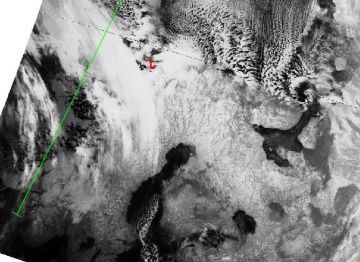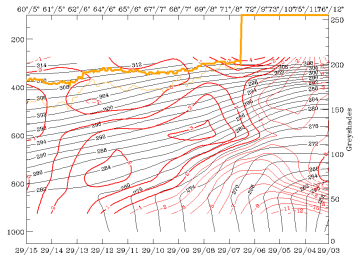The situation over the Arctic Sea before the development
|
29 January 1998/01.44 UTC - NOAA CH4 image; red: location of the surface low; position of vertical cross section indicated
|
29 January 1998/00.00 UTC - Vertical cross section; black: isentropes (ThetaE), red thin: temperature advection - CA, red thick:
temperature advection - WA, orange thin: IR pixel values, orange thick: WV pixel values
|
The NOAA image shows the typical signs for an outbreak of arctic air, such as numerous cloud streets oriented north-southwards. The area with enhanced convection is clearly seen as separate, white cloud masses north-west of Norway. A band of jet fibre cirrus extends from northern Sweden to the north-west.
The cross section shows the shallow nature of the fresh arctic cold advection. Around the area of interest (approximately 70N/10E) the cold advection is limited to the lowest 2 - 3 kilometres, which is a typical feature for arctic systems. Therefore stretching of the scale in the lowest 2 -3 kilometres would be appropriate when analyzing the cross sections of arctic (shallow) systems.
Another typical feature for the Arctic Front is the notable temperature gradient across the front. In this case the surface temperature difference was large (up to 20 degrees per 300 km on the area south of Bear Island).

